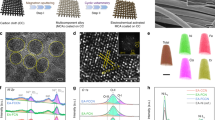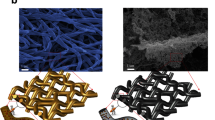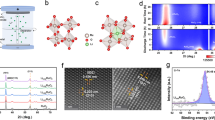Abstract
Rationally manipulating the in situ formed catalytically active surface of catalysts remains a tremendous challenge for a highly efficient water electrolysis. Here we present a cationic redox-tuning method to modulate in situ catalyst leaching and to redirect the dynamic surface restructuring of layered LiCoO2–xClx (x = 0, 0.1 or 0.2), for the electrochemical oxygen evolution reaction (OER). Chlorine doping lowered the potential to trigger in situ cobalt oxidation and lithium leaching, which induced the surface of LiCoO1.8Cl0.2 to transform into a self-terminated amorphous (oxy)hydroxide phase during the OER. In contrast, Cl-free LiCoO2 required higher electrochemical potentials to initiate the in situ surface reconstruction to spinel-type Li1±xCo2O4 and longer cycles to stabilize it. Surface-restructured LiCoO1.8Cl0.2 outperformed many state-of-the-art OER catalysts and demonstrated remarkable stability. This work makes a stride in modulating surface restructuring and in designing superior OER electrocatalysts via manipulating the in situ catalyst leaching.

This is a preview of subscription content, access via your institution
Access options
Access Nature and 54 other Nature Portfolio journals
Get Nature+, our best-value online-access subscription
$29.99 / 30 days
cancel any time
Subscribe to this journal
Receive 12 digital issues and online access to articles
$119.00 per year
only $9.92 per issue
Buy this article
- Purchase on Springer Link
- Instant access to full article PDF
Prices may be subject to local taxes which are calculated during checkout






Similar content being viewed by others
Data availability
Most data supporting the findings of this study are available from the main text of the article and its Supplementary Information. More data can be obtained from the corresponding authors upon reasonable request.
References
Körner, A., Tam, C., Bennett, S. & Gagné, J. Technology Roadmap—Hydrogen and Fuel Cells (International Energy Agency, 2015).
Jin, S. Are metal chalcogenides, nitrides, and phosphides oxygen evolution catalysts or bifunctional catalysts? ACS Energy Lett. 2, 1937–1938 (2017).
Suen, N.-T. et al. Electrocatalysis for the oxygen evolution reaction: recent development and future perspectives. Chem. Soc. Rev. 46, 337–365 (2017).
Song, F. et al. Transition metal oxides as electrocatalysts for the oxygen evolution reaction in alkaline solutions: an application-inspired renaissance. J. Am. Chem. Soc. 140, 7748–7759 (2018).
Li, T. et al. Atomic-scale insights into surface species of electrocatalysts in three dimensions. Nat. Catal. 1, 300–305 (2018).
Friebel, D. et al. Identification of highly active Fe sites in (Ni,Fe)OOH for electrocatalytic water splitting. J. Am. Chem. Soc. 137, 1305–1313 (2015).
Subbaraman, R. et al. Trends in activity for the water electrolyser reactions on 3d M(Ni,Co,Fe,Mn) hydr(oxy)oxide catalysts. Nat. Mater. 11, 550–557 (2012).
Man, I. C. et al. Universality in oxygen evolution electrocatalysis on oxide surfaces. ChemCatChem 3, 1159–1165 (2011).
Suntivich, J., May, K. J., Gasteiger, H. A., Goodenough, J. B. & Shao-Horn, Y. A perovskite oxide optimized for oxygen evolution catalysis from molecular orbital principles. Science 334, 1383–1385 (2011).
Grimaud, A. et al. Double perovskites as a family of highly active catalysts for oxygen evolution in alkaline solution. Nat. Commun. 4, 2439 (2013).
Fabbri, E. et al. Dynamic surface self-reconstruction is the key of highly active perovskite nano-electrocatalysts for water splitting. Nat. Mater. 16, 925–931 (2017).
Jiang, H., He, Q., Zhang, Y. & Song, L. Structural self-reconstruction of catalysts in electrocatalysis. Acc. Chem. Res. 51, 2968–2977 (2018).
Bergmann, A. et al. Unified structural motifs of the catalytically active state of Co(oxyhydr)oxides during the electrochemical oxygen evolution reaction. Nat. Catal. 1, 711–719 (2018).
Jiang, H. et al. Tracking structural self-reconstruction and identifying true active sites toward cobalt oxychloride precatalyst of oxygen evolution reaction. Adv. Mater. 31, 1805127 (2019).
Bergmann, A. et al. Reversible amorphization and the catalytically active state of crystalline Co3O4 during oxygen evolution. Nat. Commun. 6, 8625 (2015).
Seitz, L. C. et al. A highly active and stable IrOx/SrIrO3 catalyst for the oxygen evolution reaction. Science 353, 1011–1014 (2016).
Chung, D. Y. et al. Dynamic stability of active sites in hydr(oxy)oxides for the oxygen evolution reaction. Nat. Energy 5, 222–230 (2020).
Grimaud, A. et al. Activating lattice oxygen redox reactions in metal oxides to catalyse oxygen evolution. Nat. Chem. 9, 457–465 (2017).
Hua, B. et al. Activating p-blocking centers in perovskite for efficient water splitting. Chem 4, 2902–2916 (2018).
Wang, J. et al. Water splitting with an enhanced bifunctional double perovskite. ACS Catal. 8, 364–371 (2018).
Wu, T. et al. Iron-facilitated dynamic active-site generation on spinel CoAl2O4 with self-termination of surface reconstruction for water oxidation. Nat. Catal. 2, 763–772 (2019).
Zhang, S. et al. Spontaneous delithiation under operando condition triggers formation of an amorphous active layer in spinel cobalt oxides electrocatalyst toward oxygen evolution. ACS Catal. 9, 7389–7397 (2019).
Burke, M. S., Enman, L. J., Batchellor, A. S., Zou, S. & Boettcher, S. W. Oxygen evolution reaction electrocatalysis on transition metal oxides and (oxy)hydroxides: activity trends and design principles. Chem. Mater. 27, 7549–7558 (2015).
Burke, M. S., Kast, M. G., Trotochaud, L., Smith, A. M. & Boettcher, S. W. Cobalt–iron (oxy)hydroxide oxygen evolution electrocatalysts: the role of structure and composition on activity, stability, and mechanism. J. Am. Chem. Soc. 137, 3638–3648 (2015).
Trotochaud, L., Young, S. L., Ranney, J. K. & Boettcher, S. W. Nickel–iron oxyhydroxide oxygen-evolution electrocatalysts: the role of intentional and incidental iron incorporation. J. Am. Chem. Soc. 136, 6744–6753 (2014).
Zheng, X. et al. Electronic structure engineering of LiCoO2 toward enhanced oxygen electrocatalysis. Adv. Energy Mater. 9, 1803482 (2019).
Maiyalagan, T., Jarvis, K. A., Therese, S., Ferreira, P. J. & Manthiram, A. Spinel-type lithium cobalt oxide as a bifunctional electrocatalyst for the oxygen evolution and oxygen reduction reactions. Nat. Commun. 5, 3949 (2014).
Gardner, G. P. et al. Structural requirements in lithium cobalt oxides for the catalytic oxidation of water. Angew. Chem. Int. Ed. 51, 1616–1619 (2012).
Lu, Z. et al. Electrochemical tuning of layered lithium transition metal oxides for improvement of oxygen evolution reaction. Nat. Commun. 5, 4345 (2014).
Lu, Z. et al. Identifying the active surfaces of electrochemically tuned LiCoO2 for oxygen evolution reaction. J. Am. Chem. Soc. 139, 6270–6276 (2017).
Ceder, G. & Van der Ven, A. Phase diagrams of lithium transition metal oxides: investigations from first principles. Electrochim. Acta 45, 131–150 (1999).
Meng, Y. S. & Arroyo-de Dompablo, M. E. First principles computational materials design for energy storage materials in lithium ion batteries. Energy Environ. Sci. 2, 589–609 (2009).
Gardner, G. et al. Structural basis for differing electrocatalytic water oxidation by the cubic, layered and spinel forms of lithium cobalt oxides. Energy Environ. Sci. 9, 184–192 (2016).
Lu, X. et al. New insight into the atomic structure of electrochemically delithiated O3-Li(1–x)CoO2 (0 ≤ x ≤ 0.5) nanoparticles. Nano Lett. 12, 6192–6197 (2012).
Li, G., Zhou, S., Wang, P. & Zhao, J. Halogen-doping in LiCoO2 cathode materials for Li-ion batteries: insights from ab initio calculations. RSC Adv. 5, 107326–107332 (2015).
Kim, B.-J. et al. Functional role of Fe-doping in Co-based perovskite oxide catalysts for oxygen evolution reaction. J. Am. Chem. Soc. 141, 5231–5240 (2019).
Patridge, C. J., Love, C. T., Swider-Lyons, K. E., Twigg, M. E. & Ramaker, D. E. In-situ X-ray absorption spectroscopy analysis of capacity fade in nanoscale-LiCoO2. J. Solid State Chem. 203, 134–144 (2013).
Nakai, I. et al. X-ray absorption fine structure and neutron diffraction analyses of de-intercalation behavior in the LiCoO2 and LiNiO2 systems. J. Power Sources 68, 536–539 (1997).
Yoon, W.-S. et al. Oxygen contribution on Li-ion intercalation−deintercalation in LiCoO2 investigated by O K-edge and Co L-edge X-ray absorption spectroscopy. J. Phys. Chem. B 106, 2526–2532 (2002).
Chen, C.-H. et al. Soft X-ray absorption spectroscopy studies on the chemically delithiated commercial LiCoO2 cathode material. J. Power Sources 174, 938–943 (2007).
Ismail, J., Ahmed, M. F. & Vishnu Kamath, P. Cyclic voltammetric studies of pure and doped films of cobalt hydroxide in 1 M KOH. J. Power Sources 36, 507–516 (1991).
Shan, X. et al. Bivalence Mn5O8 with hydroxylated interphase for high-voltage aqueous sodium-ion storage. Nat. Commun. 7, 13370 (2016).
Reimers, J. N. & Dahn, J. Electrochemical and in situ X-ray diffraction studies of lithium intercalation in LixCoO2. J. Electrochem. Soc. 139, 2091–2097 (1992).
Garcia, B., Farcy, J., Pereira-Ramos, J. & Baffier, N. Electrochemical properties of low temperature crystallized LiCoO2. J. Electrochem. Soc. 144, 1179–1184 (1997).
Baumung, M., Kollenbach, L., Xi, L. & Risch, M. Undesired bulk oxidation of LiMn2O4 increases overpotential of electrocatalytic water oxidation in lithium hydroxide electrolytes. ChemPhysChem 20, 2981–2988 (2019).
Zhou, J. et al. Voltage- and time-dependent valence state transition in cobalt oxide catalysts during the oxygen evolution reaction. Nat. Commun. 11, 1984 (2020).
Yang, W. & Devereaux, T. P. Anionic and cationic redox and interfaces in batteries: advances from soft X-ray absorption spectroscopy to resonant inelastic scattering. J. Power Sources 389, 188–197 (2018).
Zhang, J.-N. et al. Trace doping of multiple elements enables stable battery cycling of LiCoO2 at 4.6 V. Nat. Energy 4, 594–603 (2019).
Grimaud, A., Hong, W. T., Shao-Horn, Y. & Tarascon, J.-M. Anionic redox processes for electrochemical devices. Nat. Mater. 15, 121–126 (2016).
Lee, S. W. et al. The nature of lithium battery materials under oxygen evolution reaction conditions. J. Am. Chem. Soc. 134, 16959–16962 (2012).
Newville, M. IFEFFIT: interactive XAFS analysis and FEFF fitting. J. Synchrotron Radiat. 8, 322–324 (2001).
Kresse, G. & Furthmüller, J. Efficient iterative schemes for ab initio total-energy calculations using a plane-wave basis set. Phys. Rev. B 54, 11169 (1996).
Kresse, G. & Furthmüller, J. Efficiency of ab-initio total energy calculations for metals and semiconductors using a plane-wave basis set. Comput. Mater. Sci. 6, 15–50 (1996).
Blöchl, P. E. Projector augmented-wave method. Phys. Rev. B 50, 17953 (1994).
Perdew, J. P., Burke, K. & Ernzerhof, M. Generalized gradient approximation made simple. Phys. Rev. Lett. 77, 3865 (1996).
Zhou, F., Cococcioni, M., Marianetti, C. A., Morgan, D. & Ceder, G. First-principles prediction of redox potentials in transition-metal compounds with LDA + U. Phys. Rev. B 70, 23521 (2004).
Yu, M. & Trinkle, D. R. Accurate and efficient algorithm for Bader charge integration. J. Chem. Phys. 134, 064111 (2011).
Bajdich, M., García-Mota, M., Vojvodic, A., Nørskov, J. K. & Bell, A. T. Theoretical investigation of the activity of cobalt oxides for the electrochemical oxidation of water. J. Am. Chem. Soc. 135, 13521–13530 (2013).
Su, D., Dou, S. & Wang, G. Single crystalline Co3O4 nanocrystals exposed with different crystal planes for Li–O2 batteries. Sci. Rep. 4, 5767 (2014).
Reikowski, F. et al. Operando surface X-ray diffraction studies of structurally defined Co3O4 and CoOOH thin films during oxygen evolution. ACS Catal. 9, 3811–3821 (2019).
García-Mota, M. et al. Importance of correlation in determining electrocatalytic oxygen evolution activity on cobalt oxides. J. Phys. Chem. C. 116, 21077–21082 (2012).
Monkhorst, H. J. & Pack, J. D. Special points for Brillouin-zone integrations. Phys. Rev. B 13, 5188–5192 (1976).
Mathew, K., Sundararaman, R., Letchworth-Weaver, K., Arias, T. & Hennig, R. G. Implicit solvation model for density-functional study of nanocrystal surfaces and reaction pathways. J. Chem. Phys. 140, 084106 (2014).
Acknowledgements
We acknowledge the National Research Foundation of Korea (NRF) grants funded by the Korean government (MSIT) (no. NRF-2018M1A2A2063868, no. NRF-2019R1A4A1025848, no. NRF-2019M3E6A1065102, no. 2015M3D1A1070639, and no. NRF-2018R1C1B6006854). J. Lim also acknowledges support from the Samsung Science and Technology Foundation under project no. SRFC-MA2002-04. We express thanks to the staff and crew of the Seoul National University Electron Microscopy Facility (NCIRF), Research Institute of Advanced Materials (RIAM), the Institute of Applied Physics of Seoul National University and the Seoul National University Co-operative Flexible Transformative (SOFT) Foundry. J.W. gratefully acknowledges the SNU Science Fellowship (NRF-2019R1A6A1A10073437) funded by the Korean government (MSIT).
Author information
Authors and Affiliations
Contributions
J.W. contributed to the experimental planning, sample preparation, electrochemical experiments, synchrotron-based experiments, data analysis and manuscript preparation. S.-J.K., Y.G., H.S. and Hyungjun Kim conducted the DFT calculations and contributed to manuscript preparation. S.C., K.H.C., J.K. and M.G.K. supported the operando XAFS and ex situ sXAS experiments. J.H. and S.-P.C. conducted the TEM/STEM analysis. S.J. and Hwiho Kim contributed to the ICP-MS and XPS tests. Q.L. and W.Y. performed the RIXS experiments. J. Liu., F.C., X.L. and S.Y. assisted with the sample preparation, electrochemical test, data acquisition and analysis. J. Lim. supervised the project and contributed to the experimental planning, data analysis and manuscript preparation. All authors reviewed and commented on the manuscript before publication.
Corresponding authors
Ethics declarations
Competing interests
The authors declare no competing interests.
Additional information
Peer review information Nature Catalysis thanks Marcel Risch, Kirsten Winther and the other, anonymous, reviewer(s) for their contribution to the peer review of this work.
Publisher’s note Springer Nature remains neutral with regard to jurisdictional claims in published maps and institutional affiliations.
Supplementary information
Supplementary Information
Supplementary Figs. 1–40, Tables 1–11 and Notes 1–7.
Supplementary Data
DFT-optimized structures.
Rights and permissions
About this article
Cite this article
Wang, J., Kim, SJ., Liu, J. et al. Redirecting dynamic surface restructuring of a layered transition metal oxide catalyst for superior water oxidation. Nat Catal 4, 212–222 (2021). https://doi.org/10.1038/s41929-021-00578-1
Received:
Accepted:
Published:
Issue Date:
DOI: https://doi.org/10.1038/s41929-021-00578-1
This article is cited by
-
Constructing regulable supports via non-stoichiometric engineering to stabilize ruthenium nanoparticles for enhanced pH-universal water splitting
Nature Communications (2024)
-
Distance effect of single atoms on stability of cobalt oxide catalysts for acidic oxygen evolution
Nature Communications (2024)
-
Stabilization of layered lithium-rich manganese oxide for anion exchange membrane fuel cells and water electrolysers
Nature Catalysis (2024)
-
Dynamic coordination engineering of 2D PhenPtCl2 nanosheets for superior hydrogen evolution
Nature Communications (2024)
-
Facilitating alkaline hydrogen evolution reaction on the hetero-interfaced Ru/RuO2 through Pt single atoms doping
Nature Communications (2024)



